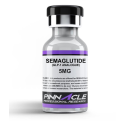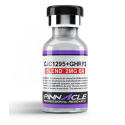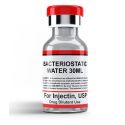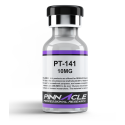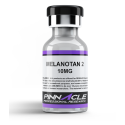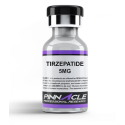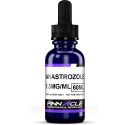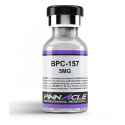Peptides vs. Proteins: Understanding the Key Differences
This website's contents, articles and product information are all provided purely for educational and informational purposes. The products that are offered on this platform are only meant to be used in in vitro research. The word "in vitro," which comes from the Latin "in glass," describes research that is done outside of a living creature. It is important to remember that these products are not pharmaceuticals or medicines, and the FDA has not approved them for use in the diagnosis, treatment, or prevention of any illnesses or disorders. It is legally forbidden for these goods to be ingested by humans or animals.
The world of biomolecules is so wide, and proteins and peptides are essential to almost all biological functions. These two types of molecules are structurally related because they consist of chains of amino acids but they also differ greatly from one another. Let's explore the key differences between peptides and proteins, shedding lights on their unique characteristics, functions, and implications for human health.
What Are Peptides and Proteins?
Let's clarify these terms before getting into the differences:
Peptides are short chains of amino acids made up of 2 to 50 amino acid residues connected by peptide bonds
Whereas proteins are bigger and more complex tiny molecules made up of one or more lengthy chains of amino acids, each of which frequently has hundreds or even thousands of residues.
Although the structural makeup of peptides and proteins is similar, the main characteristic that distinguishes them and determines their behaviour and functions in living things is their size.
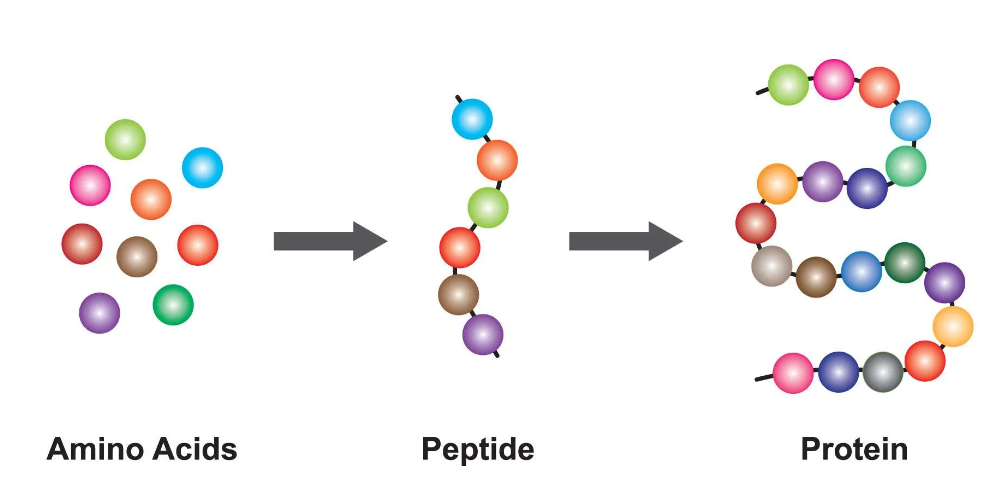
Size Matters: The Length Distinction
The most obvious distinction between peptides and proteins lies in their size or length. Peptides, being smaller molecules, generally contain fewer than 50 amino acids, while proteins are much larger, with chains consisting of 50 or more amino acid residues.
This size discrepancy has significant implications for how these molecules interact with cells and carry out their respective functions within the body.
Penetrating Power of Smaller Peptides
Due to their smaller size, peptides have an advantage when it comes to penetrating cell membranes and accessing intracellular targets. This ability allows peptides to act as potent signaling molecules, triggering specific biological responses within cells [1].
Examples of peptides that leverage this penetrating power include:
- Hormone peptides: Insulin, glucagon, and hormones released by the hypothalamus and pituitary gland play crucial roles in regulating various bodily functions.
- Antimicrobial peptides: These peptides possess antimicrobial properties and are part of the innate immune system's defense against pathogens [2].
The cell-penetrating ability of peptides has also made them attractive candidates for drug delivery systems, as they can potentially transport therapeutic cargo across cell membranes.
Diverse Roles of Larger Proteins
In contrast, proteins, with their larger and more complex structures, often serve as the workhorses of the cell, performing a wide range of essential functions:
- Structural roles: Proteins like collagen, keratin, and actin are crucial components of tissues, muscles, and other structural elements in the body.
- Enzyme/catalytic roles: Many proteins function as enzymes, catalyzing vital chemical reactions that drive metabolic processes.
- Transport and binding roles: Proteins such as hemoglobin and albumin are responsible for transporting molecules throughout the body, while others bind to specific targets, facilitating various cellular processes.
Examples of essential proteins include enzymes like DNA polymerase, structural proteins like tubulin (a component of microtubules), and transport proteins like ferritin (which stores and transports iron).
Specialized Functions of Peptides
While proteins handle many of the heavy-lifting duties in the body, peptides often play more specialized roles, acting as signaling molecules, hormones, or even antibiotics.
Peptide Hormones
Peptide hormones are produced by various glands and tissues in the body and play crucial roles in regulating numerous physiological processes. Examples include:
- Insulin: Produced by the pancreas, this peptide hormone regulates blood sugar levels.
- Glucagon: Also produced by the pancreas, glucagon counteracts the effects of insulin by raising blood sugar levels.
- Oxytocin: This neuropeptide is involved in childbirth, lactation, and social bonding [3].
Neuropeptides
Peptides that function in the brain and nervous system as neurotransmitters or neuromodulators are known as neuropeptides. They have the power to affect a number of CNS functions, such as behaviour, emotion, and pain perception. As examples, consider:
- Endorphins: These neuropeptides help people feel happy and comfortable while also acting as natural painkillers.
- Substance P: Contributes to inflammatory reactions and the transmission of pain.
Antimicrobial/Antibiotic Peptides
Because of antibacterial properties, certain peptides are useful companions in the battle against bacterial, viral, and fungal infections. These peptides have the ability to damage pathogens' cell membranes, hence destroying them. As examples, consider:
- Defences: Defensins are a type of antimicrobial peptides that are produced by different cells in the body and provide defence against viruses, bacteria, and fungi [4].
- Gainins: These peptides, which are derived from frog skin, have strong antibacterial and antifungal properties.
Antimicrobial peptides are appealing candidates for the development of novel antibiotics to counteract the growing danger of antibiotic resistance because of their capacity to target and kill organisms without causing resistance [5].
The GLP-1 Example
To illustrate the signaling function of peptides, let's consider the example of glucagon-like peptide-1 (GLP-1). This peptide hormone is released by the intestines in response to food intake and plays a crucial role in regulating blood sugar levels.
Upon detecting a rise in blood glucose levels after a meal, the body releases GLP-1, which triggers the following responses:
- Stimulates the pancreas to release more insulin, facilitating glucose uptake by cells.
- Slows down gastric emptying, reducing the rate at which food enters the small intestine, thereby controlling blood sugar spikes.
- Increases feelings of fullness and satiety, potentially aiding in weight management.
This example demonstrates how a relatively small peptide can act as a potent signaling molecule, orchestrating a complex cascade of physiological events to maintain glucose homeostasis.
Exceptions to the Size Rule
There are certain exceptions to the general rule that differentiating peptides from proteins can be done mostly based on size. Peptides can link together to form larger structures that work much like proteins.
For example, certain antimicrobial peptides can self-assemble into larger oligomeric structures, enhancing their ability to interact with and disrupt bacterial cell membranes.
Additionally, some peptides can undergo post-translational modifications, such as glycosylation or lipidation, which can alter their size, stability, and functional properties, blurring the line between peptides and proteins [6].
Ultimately, rather than depending only on size, the context and particular function of a biomolecule frequently dictate whether it is categorised as a protein or peptide.
Health Implications of Peptides vs Proteins
Understanding the differences between peptides and proteins has significant implications for human health and disease management.
Peptide Therapeutics
The unique properties of peptides, such as their ability to penetrate cells and exert targeted effects, have made them attractive candidates for therapeutic applications. Peptide-based drugs are being explored for various conditions, including diabetes, cancer, and neurological disorders.
For example, the GLP-1 agonists (drugs that mimic the effects of GLP-1) are used in the treatment of type 2 diabetes, as they can effectively lower blood sugar levels and promote weight loss.
Additionally, antimicrobial peptides are being investigated as potential alternatives to traditional antibiotics, as they can target and kill drug-resistant pathogens without inducing further resistance.
Impacts of Protein Deficiency or Excess
Proteins are essential for numerous bodily functions, and their deficiency or excess can have severe consequences. Protein deficiency can lead to muscle wasting, weakened immune function, impaired growth and development (particularly in children), and increased susceptibility to infections.
On the other hand, excessive protein intake, especially from certain sources, has been linked to an increased risk of kidney disease, osteoporosis, and certain cancers.
Personalized Nutrition and Peptide Responses
The possibility of customising diet according to a person's unique peptide reactions has been highlighted by recent study. For example, research has demonstrated that individual responses to specific meals or dietary regimens vary according to peptide levels, such as those of GLP-1 and ghrelin (a hunger-stimulating peptide).
It might be able to customise dietary recommendations to maximise metabolic health and weight management for each individual by comprehending these peptide-mediated reactions.
Furthermore, the bacteria in our digestive systems can produce bioactive peptides that affect our health and risk of disease, according to research on the gut microbiome. This new area of research emphasises the complex interactions that occur between gut microbes, peptide signalling pathways, and human diet.
Biomarkers and Diagnostic Applications
In addition to their therapeutic potential, peptides are also being explored as biomarkers for various diseases. For example, certain peptide patterns in the blood or other bodily fluids can serve as indicators of conditions like cancer, cardiovascular disease, or neurological disorders.
The ability to detect and measure these peptide biomarkers could lead to earlier diagnosis and more targeted treatment approaches.
Ongoing Research and Future Directions
The unique properties of peptides have made them invaluable tools in scientific research across various disciplines. For researchers looking to buy peptides for research purposes, reputable suppliers like Pinnacle Peptides offer a wide range of high-quality peptides for use in academic and industrial laboratories. These research-grade peptides play crucial roles in advancing our understanding of biological processes, developing new therapeutic interventions, and exploring novel applications in fields such as medicine, biotechnology, and material science. By providing access to diverse peptide libraries, companies like Pinnacle Peptides enable scientists to investigate the structure, function, and potential applications of these remarkable biomolecules, driving innovation and scientific discovery.
Computational Approaches and Drug Design
Researchers can now more accurately model and predict the structure and behaviour of peptides and proteins because of developments in computational biology and bioinformatics. These computational methods can help in both understanding the mechanisms of action of currently available peptide treatments as well as in the design and development of new peptide-based medications.
Synthetic Peptide Engineering
Additionally, researchers are looking into ways to create artificial peptides with better stability, target specificity, and biological activity. The therapeutic potential of these designed peptides may be increased by potentially overcoming some of the drawbacks of naturally occurring peptides.
Peptide Delivery and Formulation
One of the challenges in peptide-based therapeutics is the need to develop effective delivery systems and formulations that can protect the peptides from degradation and ensure they reach their intended targets. Researchers are investigating various strategies, including nanoparticle-based delivery systems, enzymatic modifications, and novel formulation techniques, to improve the bioavailability and efficacy of peptide drugs.
As our understanding of peptides and proteins continues to deepen, we can expect to see more innovative applications in areas such as medicine, agriculture, and biotechnology. The future holds exciting possibilities for leveraging these remarkable biomolecules to address pressing challenges and improve human health and well-being.
Conclusion
Peptides and proteins are two very different yet closely linked things in the large world of biomolecules. Even though they both have amino acid chains as their structural basis, they differ from one another in terms of size, penetration capacity, and specific roles.
Because of their reduced size and capacity to enter cells, peptides are frequently used as strong hormones, antibacterial agents, and signalling molecules. In contrast, proteins perform a wider range of jobs. They can act as transport molecules, enzymes, or structural elements, among many other things.
Understanding these distinctions holds significance not only for enhancing our knowledge of biological processes but also carries interesting implications for human well-being, covering the development of peptide-oriented medicines, handling protein-associated diseases, and customising dietary plans according to distinct peptide reactions.
As research continues to unravel the intricate workings of these biomolecules, we can expect to gain deeper insights into their roles and potential applications in improving human health and well-being.
Referenced Citations
- Fosgerau, K., & Hoffmann, T. (2015). Peptide therapeutics: Current status and future directions. Drug Discovery Today, 20(1), 122-128.
- Zasloff, M. (2002). Antimicrobial peptides of multicellular organisms. Nature, 415(6870), 389-395.
- Lee, H. J., Macbeth, A. H., Pagani, J. H., & Young, W. S. (2009). Oxytocin: The great facilitator of life. Progress in Neurobiology, 88(2), 127-151.
- Ganz, T. (2003). Defensins: Antimicrobial peptides of innate immunity. Nature Reviews Immunology, 3(9), 710-720.
- Lazzaro, B. P., Zasloff, M., & Rolff, J. (2020). Antimicrobial peptide resistance in Pathogens: A life-history perspective. Trends in Microbiology, 28(11), 869-881.
- Meier, J. J., & Nauck, M. A. (2005). Glucagon-like peptide 1(GLP-1) in biology and pathology. Diabetes/Metabolism Research and Reviews, 21(2), 91-117.



